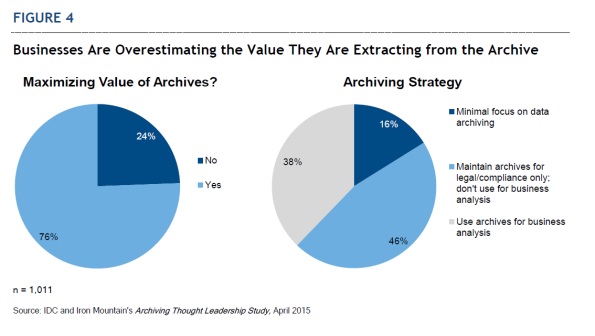Analyzing Archived Data Yields Big Returns
Page Contents
You may believe you're maximizing the value of your data archives, but a recent IDC report found most organizations are missing out on millions in potential savings and revenue opportunities.
“Mining for Insight: Rediscovering the Data Archive” reports 39 percent of companies realized $1 million or more in additional revenue in the past year by “monetizing their archives.” The average value from additional revenue was $7.5 million, but the top 15 percent reaped more than $10 million in additional revenue.
Sounds good, right? Most organizations think they are making better use of archival data than they actually are, point out IDC researchers Laura DuBois and Sean Pike in the report.
Missed Data Analytics Opportunity
“Despite such impressive numbers, many companies aren't maximizing the value of their data archives,” DuBois and Pike write. “Worse, this missed opportunity is a blind spot because organizations believe they are doing a better job realizing value from the archives than they actually are.”
Three quarters of the 1,011 senior and executive leaders surveyed believe they are maximizing the value of their archives. Yet only 38 percent use archives for data analysis, a practice IDC said is “critical to a business' ability to drive additional revenue by better understanding markets and improving products, service delivery and customer service.”

Applying data archiving helped companies achieve substantial operational savings over the past year, the report found. Slightly more than half of respondents reported savings of $1 million or more from risk mitigation or avoidance of litigation, with 44 percent citing savings of $1 million or more from reduced operational or capital costs.
Again, the top performers had far greater savings. The top 21 percent reported savings of over $10 million in risk mitigation or avoidance of litigation, while 18 percent saved more than $10 million from reduced operational or capital costs.
John Sharpe, Iron Mountain's director of product management, Data Management, said the findings reflect what he sees on the ground. Iron Mountain, a data archiving company, sponsored the report.
“We talked about getting more than $10 million in benefits, getting $7.5 million of new revenue streams,” Sharpe said in an interview. “I don't think a lot of companies, even if they believe they have an archival strategy, are actually realizing those numbers.”
One way companies are finding new money is by tapping archives for business data analytics, he explained. For instance, a company might use archived data to analyze which products outperformed others in the past five to 10 years. That allows them to make adjustments to improve future sales, he said.
“If you don't have the ability to go back and understand what happened in your business, it makes it much more difficult to predict what can happen going forward,” he said “The ability to go back and do analytics on the old data is the key to generating future value.”
‘A Fire Drill Every Time'
Companies tend to store historical data in multiple solutions, often in proprietary formats that make it difficult to find and retrieve the right information, Sharpe said. Often, those solutions are designed for back-up, rather than archiving. As a result, the data isn't mapped or cataloged before archiving it, which makes it nearly impossible to locate the right data in a timely fashion. That's a problem for business analytics, but it's especially bad if you need the data for a legal issue or compliance question.
“It's a fire drill every time,” he said. “If you do not have a strategy that allows you to go back in data that is seven to 10 years old in your company's email, you'll spend an inordinate amount of time sifting through data trying to find where the email is.”
Data Lake or Data Swamp?
Eighty-eight percent of companies lack a consistent approach to archiving data across all data types, the study found. Forty percent simply archive everything without sifting through the data. The result: Archived data is mired in a data swamp.
Companies are turning to Big Data technologies such as Hadoop-based data lakes, but Big Data can compound the problem if you lack an enterprise archival strategy, IDC found.
“Much has been written about companies' desire to maintain data lakes — easily accessible and inexpensive repositories designed to retain all data attributes — from which they can pull necessary information to make critical business decisions,” the report states. “However, this archive-everything approach leads to companies creating murky data swamps — holistic data repositories that can make information hard to find because the information is unclassified and treated inconsistently.”
Given the chaos, it's no surprise that three in four companies say they could extract at least twice the value they realize today with archived data. But it's not going to change without a concerted effort.
4 Tips to Derive Value from Archived Data
How can you turn archived data into cost savings and new revenue? To extract more value from archived data, IDC and Iron Mountain recommend:
- Adopt a holistic and consistent enterprise archiving strategy. Experts such as Gartner have long recommended that companies adopt an enterprise-wide approach to data, but it's easy to overlook archived data, which may be locked in proprietary systems. “We're at the early stages of thinking about archiving as a formalized program. However, I think the results of the study definitely indicate that if we put a little more rigor to this analysis, we get a bunch of business value out of it,” Sharpe said.
- Hire a chief data officer to “own” the data strategy. Organizations have been slow to embrace the CDO role, but Sharpe said IT, compliance and other individual business units tend to look at the data from a limited perspective. A CDO can bring a broader vision to enterprise data by looking at it from all sides, he added.
- Create an information map that identifies the types of information in archives and repositories. This map should outline which types of data you'll find in each. That sounds like a massive undertaking, but vendors such as Iron Mountain offer software to automate the process, Sharpe said.
- Work with a third-party partner that can introduce archiving expertise and best practices. While that may seem self-serving, Sharpe said a third-party partner will bring service-level agreements to data retrieval. “If you don't have a program like that, you're just looking for a needle in a haystack,” he said.
“It's in the early stages but data continues to proliferate, technology continues to proliferate, certainly the value of that data, is not insignificant,” Sharpe said. “As we look for more ways to go and either monetize or make our businesses run more efficiently, having access to that data in a more streamlined and easier to understand way is going to be good for a lot of organizations.”
Loraine Lawson covers integration technology and business issues. She is an award-winning journalist who has written for publications including TechRepublic and IT Business Edge.
